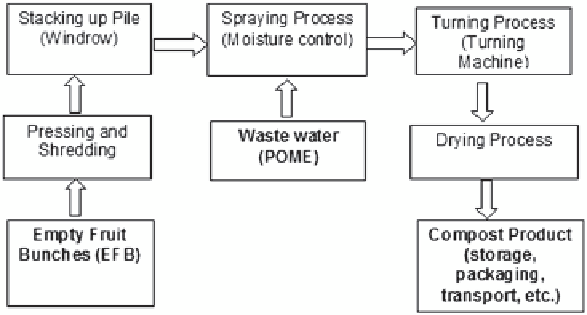Agriculture Reference
In-Depth Information
Fig. 11.5
Co-composting plant process flow. (Source: CDM-PDD
2006
)
macro, secondary and micronutrients, thus it could be appropriate to be treated as
fertilizer for oil palm plantation. Blending saw dusts obtained from furniture sec-
tor with POMS improve efficiency of composting and can mitigate the air pollu-
tion process (Bhamidimarri and Pandey
1996
; Yaser et al.
2007
). Anaerobic sludge,
waste of kitchen and saw dust were collected to facilitate the composting process
and finally it appeared like fertilizer value but still improvements are required to
make it an ultimate substrate (Yaser et al.
2007
). To overcome unexpected results of
the EFB composting process, researchers have studied various methods to improve
it (Thambirajah et al.
1995
; Salates et al.
2004
; Yaser et al.
2007
; Baharuddin et al.
2009
; Sabrina et al.
2009
).
As a result, a pilot scale study was built to investigate the quality of co-compost-
ing of EFB of oil palm with moderately treated POME (Baharuddin et al.
2009
).
Vermicomposting of EFB was evaluated by Sabrina et al. (
2009
). Static aerated
reactor was used by Yaser et al. (
2007
) to compost palm oil mill sludge with saw-
dust. In some cases, addition of ripe compost to the mass of EFB may provide a
significant effect on the degradation speed (Salates et al.
2004
). These researches,
however, did not show that composting of EFB could be shortening to below 60
days. Further research was conducted by trying different methods or treatments to
achieve a shorter composting period.
In other type of waste composting, usage of additives has been a popular method
to achieve fast composting. The compost or bio-fertilizer could be produced with
the inoculation of appropriate functional microbes which increase the decomposi-
tion rate, shorten the maturity period and improve the compost (or bio-fertilizer)
quality (Wei et al.
2007
). The degradation rate of municipal solid waste was highest
at 15.671 g kg
−1
h after seeding with a mixture inoculum of A (
Bacillus
sp.) and B
(cellulolytic strains, i.e.,
Trichoderma, Streptomyces
and white-rot fungi) (Xi et al.
2005
). The efficiency of microbe inoculums on EFB composting therefore is a wor-
thy subject to be explored (Fig.
11.5
and Table
11.6
).

